As an Amazon Associate KitchenwareSets.com earns from qualifying purchases.
Genius Farmhouse Kitchen Wall Decor Ideas For Every Budget
Tired of staring at that big, blank wall in your kitchen? You know the one.
Farmhouse kitchen wall decor is all about creating a warm, cozy, and inviting atmosphere. You want that rustic charm, but you’re not sure where to start or how to make it feel personal.
The most popular farmhouse kitchen wall decor includes rustic wood signs, oversized vintage-style clocks, functional open shelving, curated gallery walls with botanical prints, and textural pieces like wire baskets or antique cutting boards. This guide will show you genius ideas for every budget, turning your kitchen into the heart of your home.
Feeling Uninspired by Your Blank Kitchen Walls? Here’s the Fix.
Staring at a characterless kitchen can be frustrating. You want the space to feel like you—a warm, welcoming hub for family and friends, not just a place to cook. This is where the charm of farmhouse decor comes in. It’s the perfect solution for adding personality and a cozy, lived-in feel to those empty spaces.
Forget feeling overwhelmed. We’ve gathered a collection of genius, actionable ideas that work for any budget or skill level. From simple additions that add instant character to statement pieces that transform a room, you’ll find everything you need to start your kitchen refresh today. Get ready to turn those boring walls into a beautiful and inviting focal point.
9 Genius Farmhouse Kitchen Wall Decor Ideas to Try This Weekend
Ready for some inspiration? Below are nine distinct farmhouse kitchen wall decor ideas designed to help you create a space you love. We’ve included everything you need to get started, from material lists to clear, step-by-step directions. Whether you’re looking for a quick five-minute update or a satisfying weekend project, you’ll find the perfect idea to bring warmth and style to your kitchen.
1. Install Reclaimed Wood Floating Shelves for Stylish Storage
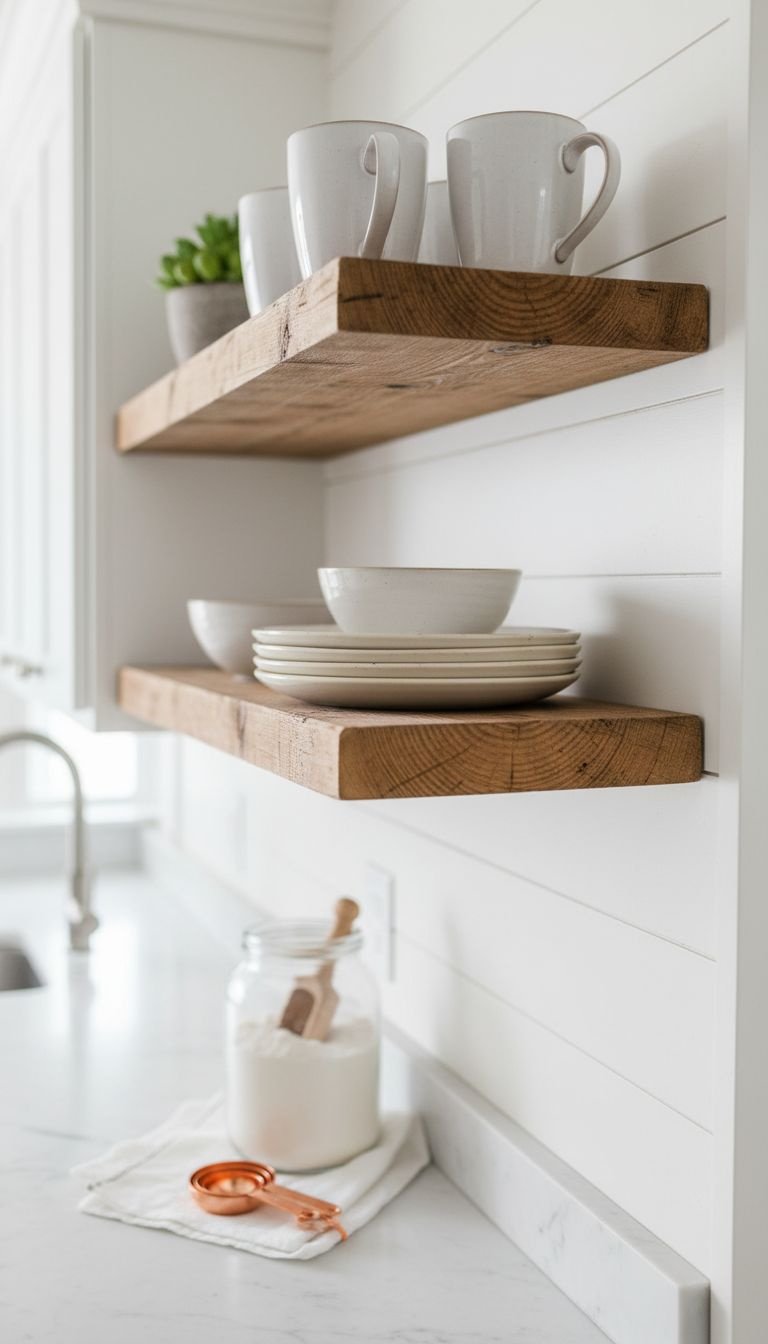
Pin this beautiful and functional idea to your ‘Kitchen Goals’ board!
Materials Needed:
- 2-3 reclaimed wood planks (at least 1.5 inches thick)
- Heavy-duty floating shelf brackets (black metal or pipe style, rated for 50+ lbs)
- Stud finder
- Power drill and appropriate bits
- Level
- Pencil
Step-by-Step Directions:
- Plan Placement: Decide on the height and spacing for your shelves. Use a pencil to mark the desired locations on the wall.
- Locate Studs: Use a stud finder to locate the wall studs. This is crucial for ensuring your shelves are secure enough to hold dishes. Mark the stud locations.
- Install Brackets: Align your brackets with the stud marks and use your drill to securely fasten them to the wall. Use a level to ensure they are perfectly straight.
- Attach Shelves: Place your reclaimed wood planks onto the brackets and secure them from underneath according to the bracket manufacturer’s instructions.
- Style Away: Arrange your favorite mugs, bowls, small plants, and cookbooks on the shelves. Mix heights and textures for a curated look.
Pro-Tip: For an authentic look, search for wood from an architectural salvage yard or use a distressing technique on new pine boards to create a time-worn patina.
2. Create a Focal Point with an Oversized Wall Clock
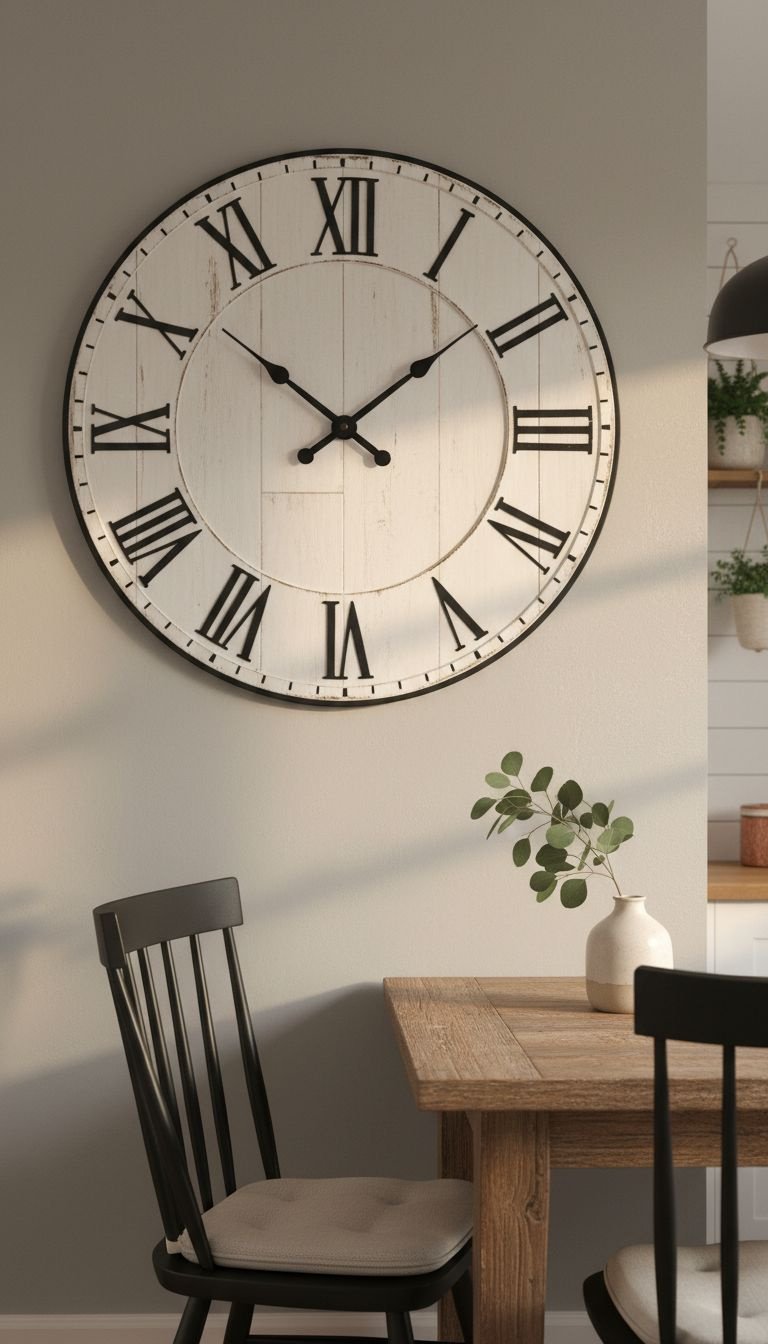
Save this timeless decor idea for your kitchen!
What You’ll Need:
- One oversized farmhouse-style wall clock (24-40 inches in diameter is ideal)
- Heavy-duty wall anchor and screw (ensure it can support the clock’s weight)
- Tape measure
- Pencil
- Level
Step-by-Step Directions:
- Choose the Spot: Identify the main blank wall in your kitchen or dining nook. This will be the new focal point.
- Find the Center: Measure the width of the wall space and mark the horizontal center point with a pencil. Decide on the height, typically eye-level or slightly above.
- Install Hanger: Following the package instructions, install the heavy-duty wall anchor at your marked spot.
- Hang and Level: Carefully hang the clock on the screw. Step back and use a level on top of the clock to make sure it’s perfectly straight, adjusting as needed.
Pro-Tip: The clock should be about two-thirds the width of the empty wall space it’s occupying. This ensures it feels intentionally scaled and not too small or overpowering.
3. Hang a Charming Rustic ‘Gather’ Sign
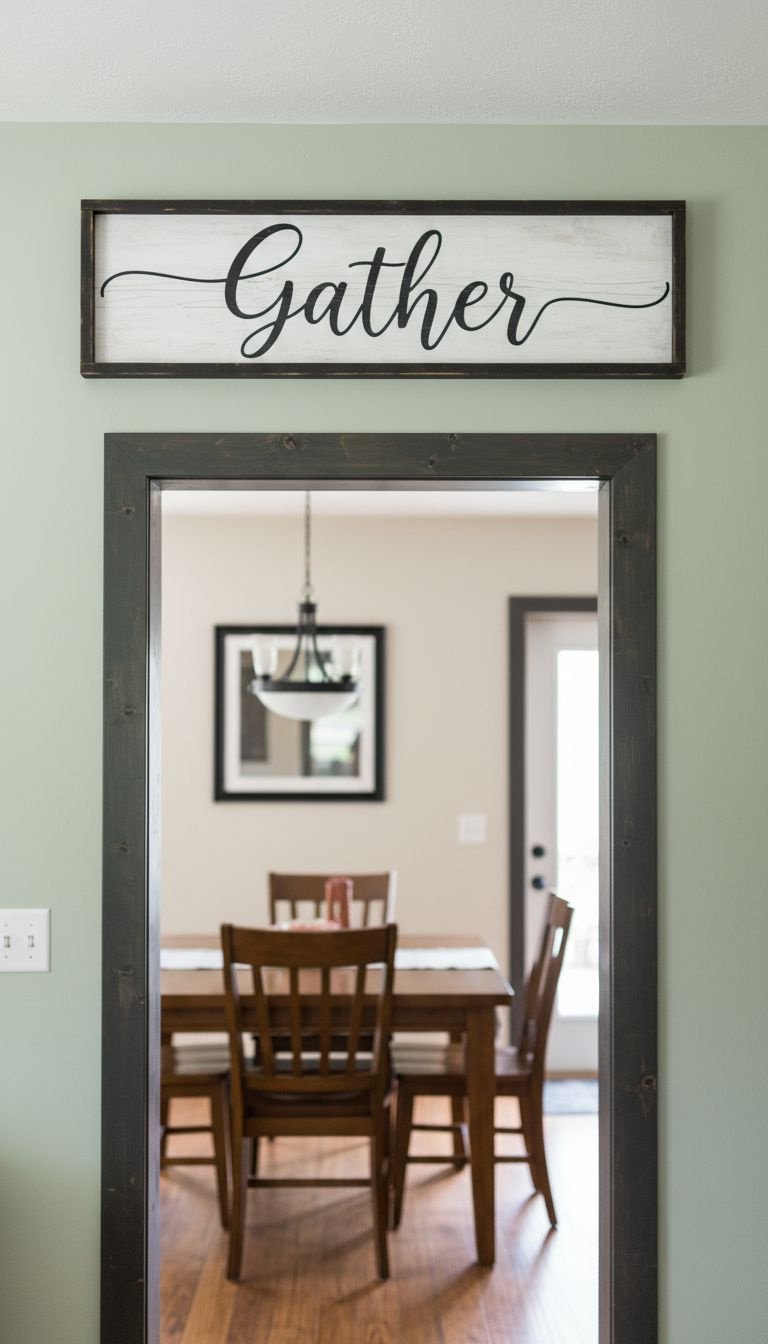
Pin this welcoming touch for your farmhouse kitchen!
What You’ll Need:
- A framed wood sign with a meaningful word (e.g., ‘Gather’, ‘Kitchen’, ‘Blessed’)
- Sawtooth hangers (if not already installed on the sign)
- Hammer
- Nails or screws with wall anchors
- Tape measure & pencil
- Level
Step-by-Step Directions:
- Pick the Perfect Spot: The space above a doorway, window, or a wide pantry door is often ideal for a long, horizontal sign.
- Measure and Mark: Measure the length of your sign. Find the center of the wall space where you plan to hang it. Mark the center point.
- Mark for Hangers: Measure the distance between the two sawtooth hangers on the back of your sign. From your center wall mark, measure out half that distance in each direction and make two new marks. These are your nail points.
- Level and Hang: Use a level to ensure your two nail marks are perfectly horizontal. Install your nails or screws. Hang the sign and enjoy the immediate warmth it brings.
Lesson Learned: Avoid word art with generic or overused phrases. Choose a single, powerful word that resonates with you and your family to keep the look feeling personal and sophisticated.
4. Design a Gallery Wall of Vintage Botanicals
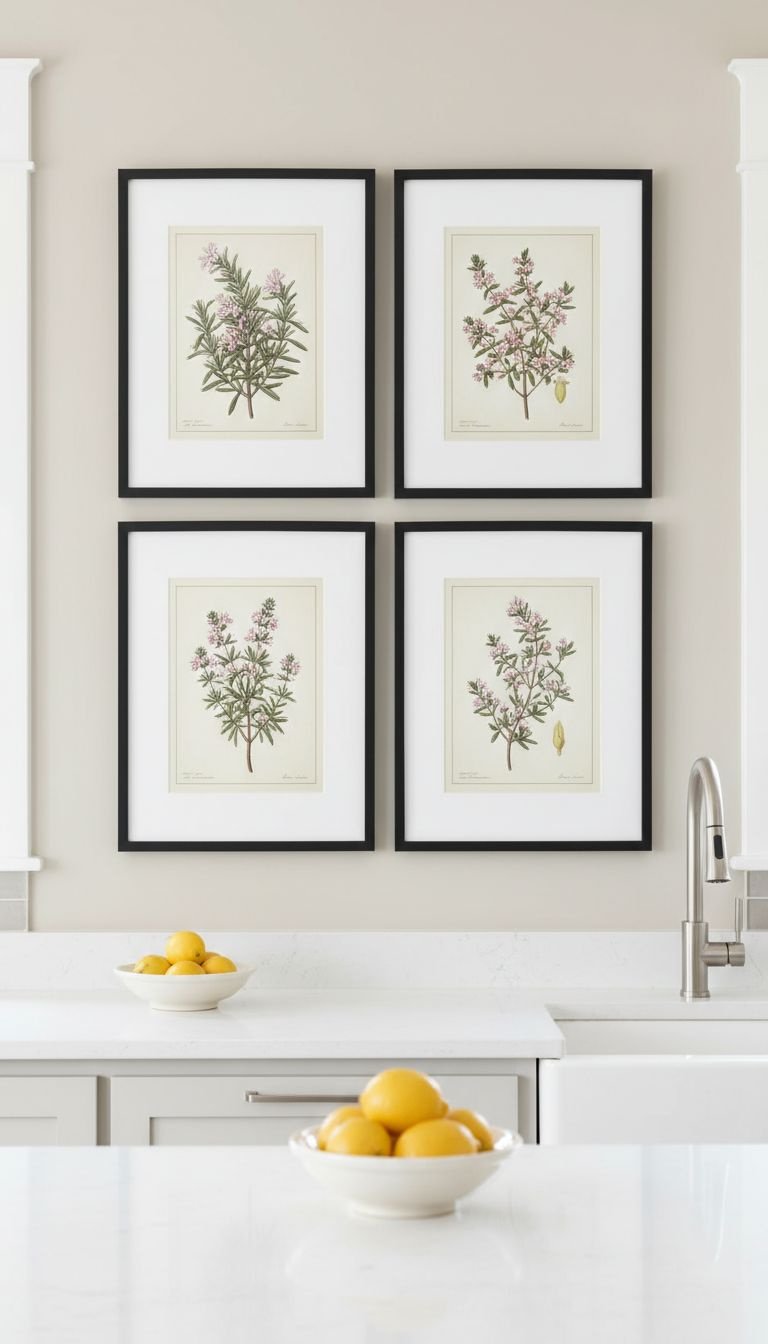
Save this elegant gallery wall idea for a touch of nature!
Materials Needed:
- A set of 4-6 matching botanical or herb prints
- Identical frames with matting (simple black or natural wood frames work best)
- Kraft paper or wrapping paper
- Scissors and painter’s tape
- Picture hanging nails and hammer
- Level and tape measure
Step-by-Step Directions:
- Trace Your Frames: Trace each frame onto a piece of kraft paper and cut out the shapes. These are your templates.
- Plan on the Floor: Arrange the paper templates on the floor until you find a layout you love. A simple grid is a classic choice.
- Tape to the Wall: Using painter’s tape, stick the paper templates on the wall in your desired arrangement. Use a level and tape measure to ensure spacing is even (aim for 2-3 inches between each frame).
- Nail and Hang: Hammer a nail directly through the top center of each paper template. Once all nails are in place, tear away the paper.
- Hang Your Art: Hang your framed prints on the corresponding nails. Step back and admire your perfectly planned gallery wall!
Pro-Tip: For a budget-friendly version, find high-resolution vintage botanical images online from public domain sources and have them printed at your local office supply store.
5. Add Rustic Texture with a Wire Basket Display
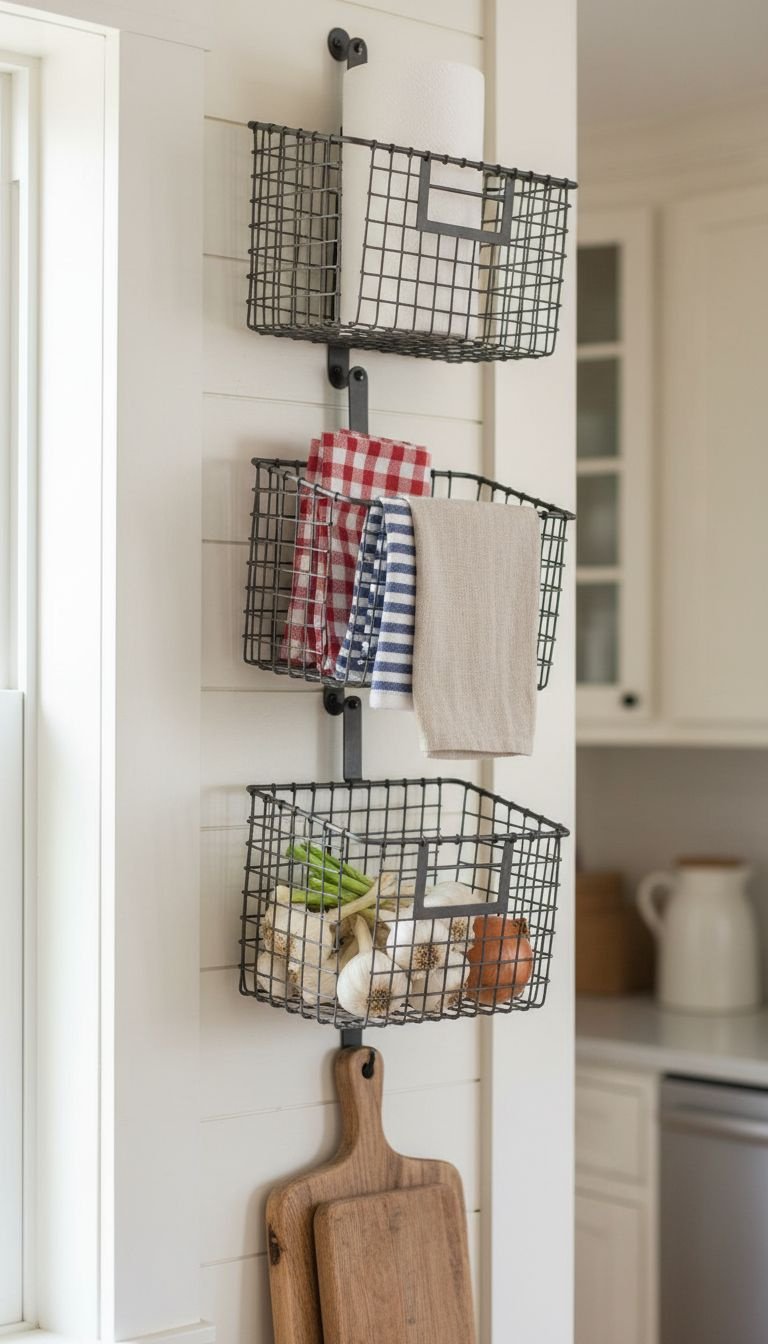
Pin this practical and pretty storage solution!
What You’ll Need:
- A set of 2-3 wall-mountable wire baskets (galvanized metal or black finish)
- Screws and wall anchors appropriate for your wall type
- Power drill
- Level
- Tape measure and pencil
Step-by-Step Directions:
- Find a Nook: Identify a small, vertical strip of wall that could use some love, like the space next to the stove or at the end of a cabinet run.
- Plan Your Spacing: Hold the baskets up to the wall to decide on the vertical spacing. Aim for at least 6-8 inches between each basket so you have room to access the contents.
- Mark and Drill: Use your tape measure, level, and pencil to mark where the screws for the top basket will go. Drill pilot holes and insert wall anchors if not drilling into a stud.
- Mount and Repeat: Screw the first basket securely to the wall. Measure down from it to position the next basket, ensuring it’s vertically aligned, and repeat the process until all baskets are hung.
- Fill with Function: Use your new baskets to store produce like onions and garlic, rolled-up dish towels, or even mail.
Pro-Tip: Line the bottom of one basket with a folded linen napkin before adding produce to catch any debris and add another layer of soft texture.
6. Incorporate a Functional & Stylish Chalkboard Menu
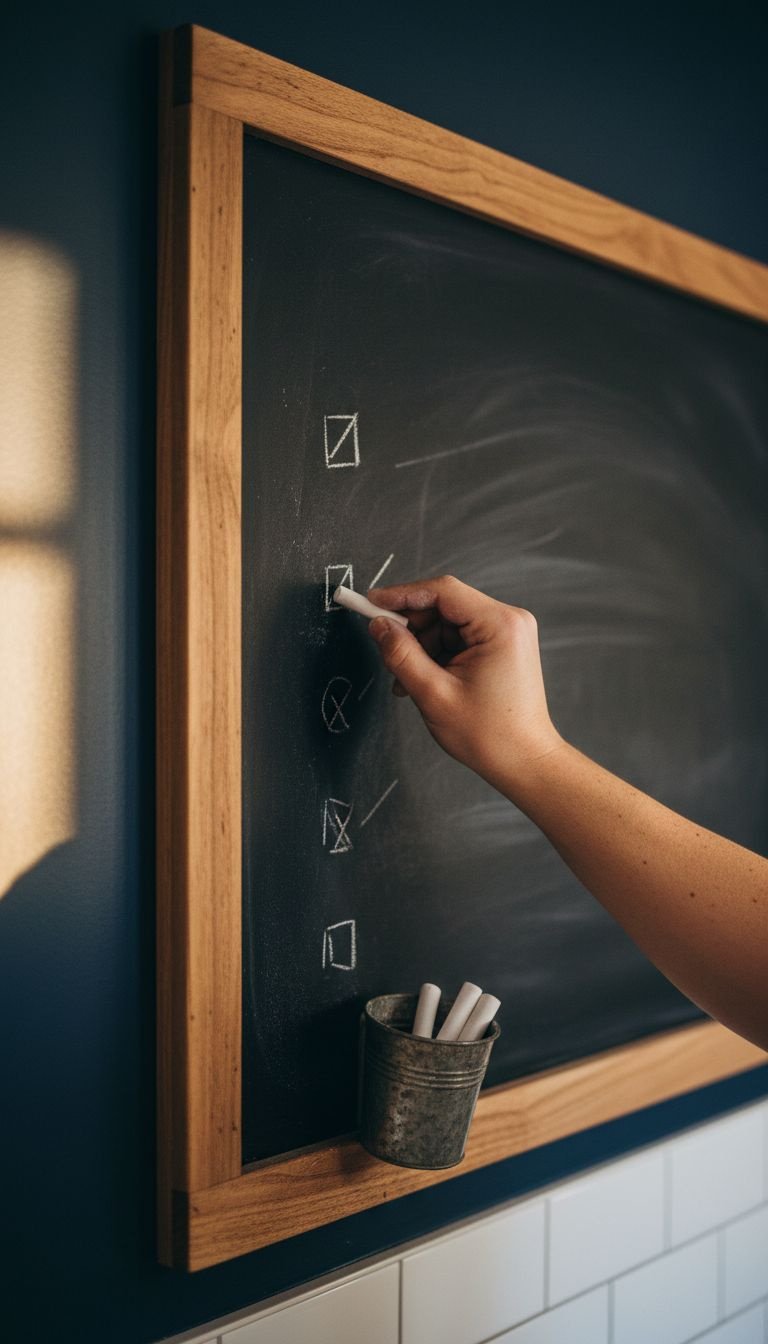
Save this fun and functional family command center idea!
What You’ll Need:
- A large, wood-framed chalkboard
- Chalk or chalk markers
- A soft cloth or chalkboard eraser
- Picture hanging wire rated for the chalkboard’s weight
- 2 heavy-duty picture hooks and nails
- Tape measure, pencil, and level
Step-by-Step Directions:
- Prep the Chalkboard: Before first use, “season” the chalkboard by rubbing the side of a piece of chalk over the entire surface, then wiping it clean with a dry cloth. This prevents the first words you write from “burning” into the surface.
- Install Hanging Wire: If not already attached, install the picture hanging wire on the back of the frame, about one-third of the way down from the top on both sides.
- Mark Hook Placement: Decide where you want to hang the board. Hold it up to the wall and lightly mark the top center. Measure down from that mark to where the taut wire will be, and then mark your two hook locations, ensuring they are level.
- Hang Securely: Install the two hooks and carefully hang your chalkboard. Using two hooks provides more stability than one.
- Get Creative: Use your new board for weekly menus, grocery lists, inspirational quotes, or doodles from the kids.
Pro-Tip: For a more permanent header like “Menu” or “Groceries,” use a permanent paint pen or a vinyl decal. This saves you from having to rewrite it every time.
7. Display a Collection of Antique Cutting Boards
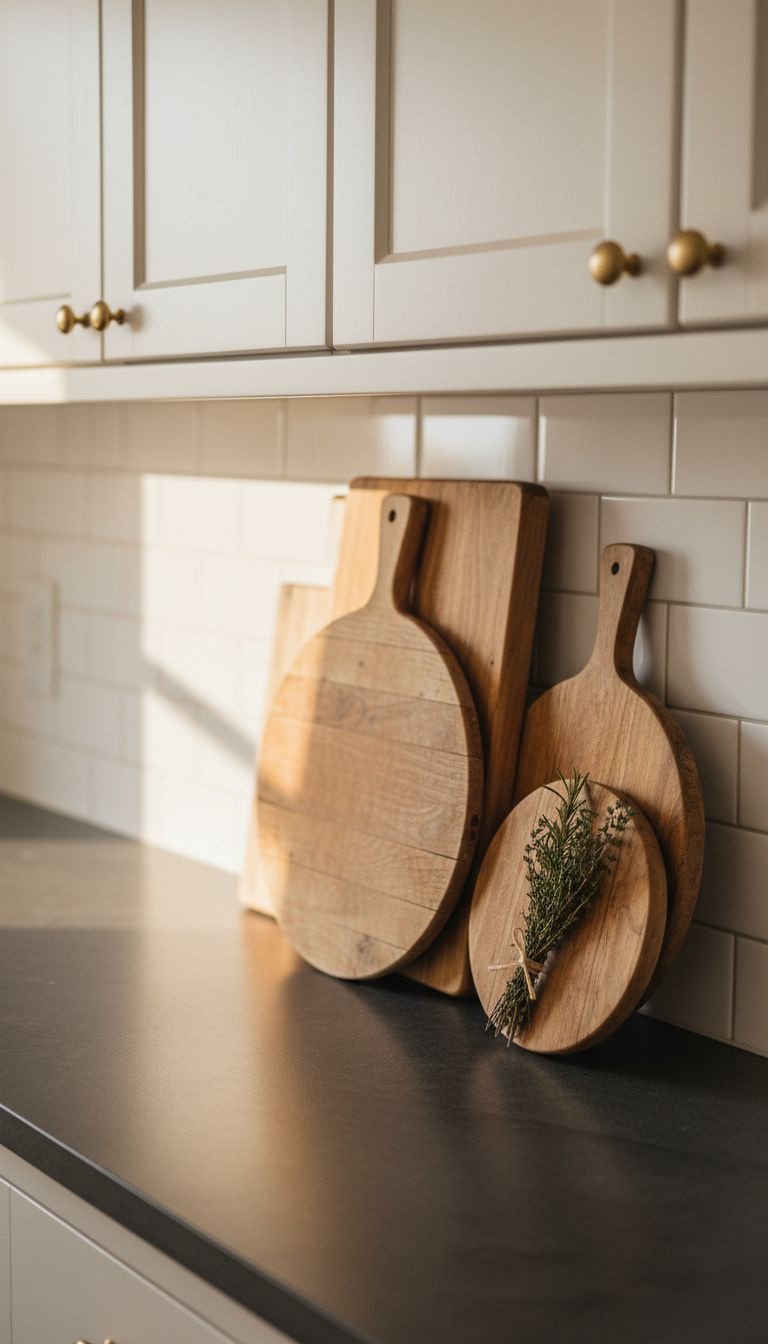
Save this simple trick for adding instant warmth and character!
What You’ll Need:
- A collection of 3-5 wooden cutting boards in various shapes, sizes, and wood tones. (Look for ones with handles or interesting shapes).
- Wood conditioning oil or food-safe mineral oil
- A soft cloth
Step-by-Step Directions:
- Source Your Boards: Hunt for unique cutting boards at thrift stores, flea markets, and antique shops. The more varied the shapes and patinas, the better.
- Clean and Condition: Thoroughly clean the boards with warm, soapy water and let them dry completely. Apply a generous amount of conditioning oil with a soft cloth to bring out the richness of the wood grain.
- Start Layering: Find a corner of your kitchen counter. Place the largest cutting board at the back, leaning it against the backsplash.
- Build Forward: Layer the medium and smaller boards in front, overlapping them slightly. Play with the arrangement until it looks balanced and effortlessly collected.
- Add an Accent: Lean a small piece of framed art or place a small vase of greenery in front of the collection for a final touch.
Lesson Learned: Don’t be afraid to mix old and new! A brand new acacia wood board can look beautiful layered with a time-worn vintage breadboard. The mix of finishes adds to the charm.
8. Frame a Window with a Simple Boxwood Wreath
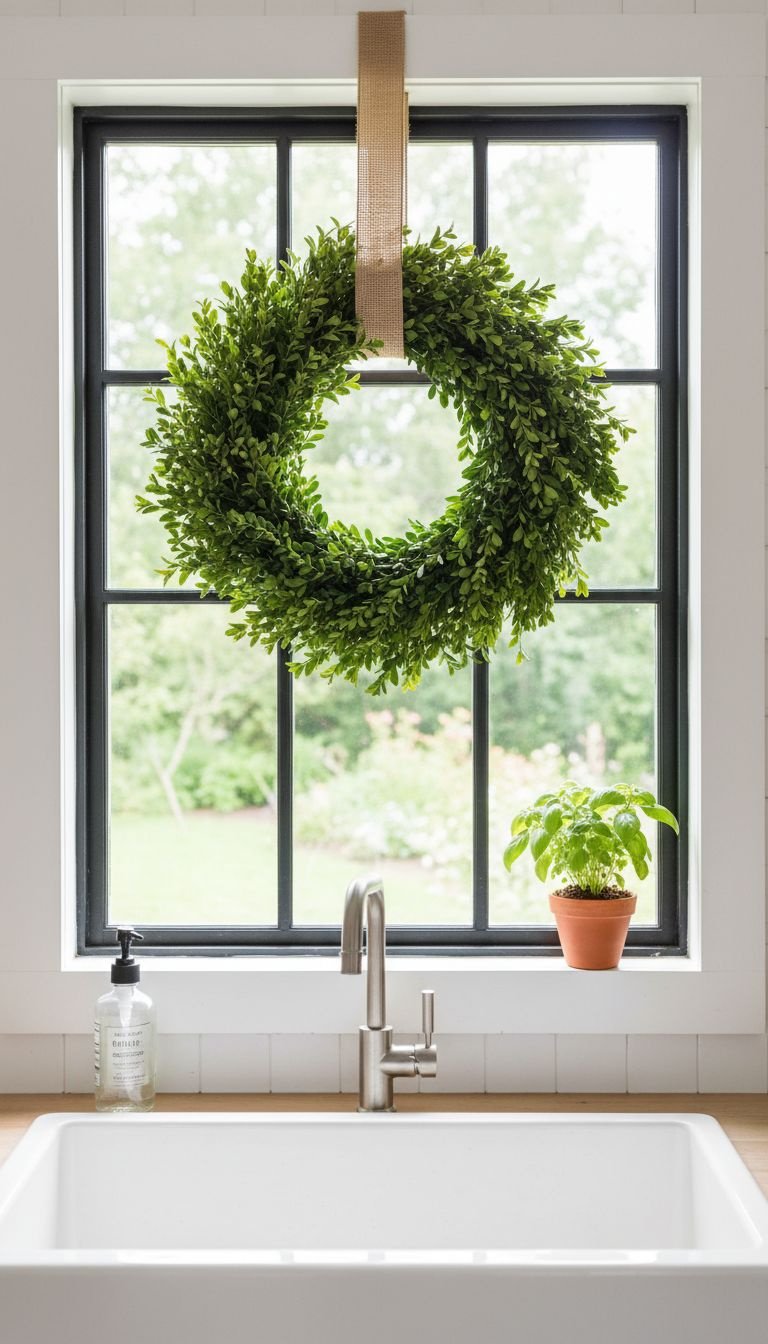
Pin this fresh and simple idea for year-round greenery!
What You’ll Need:
- One preserved boxwood or high-quality faux eucalyptus wreath (8-12 inches in diameter)
- 2-inch wide ribbon in a natural material like burlap, linen, or ticking stripe
- A small, clear adhesive hook or a small nail
- Scissors
Step-by-Step Directions:
- Choose Your Spot: This works best on a window without blinds, or on the decorative mullions of a larger window.
- Attach the Ribbon: Loop the ribbon through the wreath and tie a simple knot or bow at the top, leaving a long tail.
- Determine the Hanging Height: Hold the wreath up to the window to decide how low you want it to hang. Typically, the center of the window is a good height.
- Secure the Hanger: Place the clear adhesive hook on the top of the window frame or sash. If you prefer, you can also use a small nail.
- Hang and Adjust: Hang the ribbon loop over the hook. Trim any excess ribbon at an angle for a clean finish.
Pro-Tip: Change out the ribbon seasonally! Use a red velvet ribbon for the holidays, a pastel linen for spring, and a simple twine for a rustic summer look.
9. Use Architectural Salvage as Unique Wall Art

Save this unique idea for adding authentic farmhouse character!
What You’ll Need:
- A piece of architectural salvage (e.g., an old window frame, a decorative corbel, a section of a tin ceiling tile)
- Heavy-duty picture hanging hardware appropriate for the item’s weight (like D-rings and wire)
- Wall anchors and screws
- Drill, level, tape measure, and pencil
Step-by-Step Directions:
- Go on a Treasure Hunt: Visit local flea markets, antique stores, or architectural salvage yards to find a piece that speaks to you. Look for items with interesting shapes and textures.
- Clean and Seal: Gently clean the piece with a damp cloth, being careful not to remove too much of the aged patina. If the paint is very chippy, you may want to seal it with a clear, matte sealant to prevent flaking.
- Install Hardware: Securely attach D-rings and picture hanging wire to the back of the piece. For heavy items, consider using a French cleat for maximum security.
- Mount Securely: This step is crucial. Locate wall studs whenever possible. Use robust wall anchors and screws to ensure your unique piece of history is safely and securely mounted to the wall.
Pro-Tip: You can hang a small wreath or a bundle of dried herbs from the center of an old window frame to add another layer of dimension and a pop of color.
Key Takeaways: Your Quick Guide to Farmhouse Kitchen Walls
- Embrace Texture: Mix materials like rough wood, smooth metal, and soft greenery to create visual interest and prevent a neutral space from feeling flat.
- Prioritize Scale: Choose one large “hero” piece for a big wall, or group smaller items into a cohesive gallery wall. Avoid small, floating items that look lost.
- Blend Old and New: The most authentic farmhouse spaces combine genuine vintage finds with new, farmhouse-style pieces for a look that feels collected over time.
- Function Can Be Beautiful: Use practical items like open shelves, cutting boards, and chalkboards as part of your decor to honor the style’s utilitarian roots.
- Edit Yourself: The key to a sophisticated farmhouse look is avoiding clutter. Leave some “white space” on your walls and shelves to let your chosen pieces shine.
People Also Ask About Farmhouse Kitchen Wall Decor
Is the farmhouse style still popular in 2025?
Yes, the farmhouse style remains very popular, but it has evolved. The modern farmhouse aesthetic, which features cleaner lines, neutral color palettes, and a less cluttered approach, is currently the most prominent version of the style. The trend is moving away from excessive word art and towards more authentic materials and unique, vintage pieces.
How do I make my kitchen look farmhouse on a budget?
Focus on high-impact, low-cost projects. Start by hunting for unique cutting boards, pitchers, and frames at thrift stores. Try a simple DIY project, like distressing a picture frame with chalk paint and sandpaper. You can also install simple, affordable pine shelves with black brackets to get the open-shelving look for less.
What can I put on the wall above my kitchen cabinets?
Use the space for decorative, low-use items. A collection of white ceramic pitchers, a row of wire baskets, or a few large, faux plants can look beautiful. The key is to keep it simple and uncluttered. Choose items with varying heights to create visual interest, but don’t overfill the space.
Final Thoughts
Decorating your kitchen walls is a journey, not a destination. The goal is to create a space that feels warm, inviting, and uniquely you. Don’t be afraid to start small—one or two changes can make a huge difference. Choose pieces that you genuinely love, and you’ll build a kitchen that’s not just stylish, but also full of personality.
Which of these ideas are you most excited to try in your own kitchen? Let us know in the comments below
Last update on 2025-12-14 at 05:52 / Affiliate links / Images from Amazon Product Advertising API
